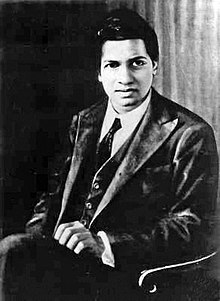1729 (liczba)
| faktoryzacja |
| ||||||
|---|---|---|---|---|---|---|---|
| dzielniki |
1, 7, 13, 19, 91, 133, 247, 1729 | ||||||
| zapis rzymski |
MDCCXXIX | ||||||
| dwójkowo |
11011000001 | ||||||
| ósemkowo |
3301 | ||||||
| szesnastkowo |
6C1 | ||||||
| Wartości funkcji teorioliczbowych | |||||||
| |||||||
1729 (tysiąc siedemset dwadzieścia dziewięć) – liczba naturalna następująca po 1728 i poprzedzająca 1730.


W matematyce[edytuj | edytuj kod]
- 1729 jest najmniejszą liczbą taksówkową[1]
- 1729 jest liczbą Harshada[2]
- 1729 jest trzecią liczbą Carmichaela[3]
- 1729 jest liczbą Protha[4]
- 1729 jest liczbą Zeisela[5]
- 1729 jest liczbą sfeniczną[6]
- 1729 jest liczbą bezkwadratową[7]
- 1729 jest jedną z czterech liczb, które po dodaniu do siebie cyfr je tworzących (1 + 7 + 2 + 9 = 19), a następnie przemnożeniu otrzymanego wyniku przez jego odwrotność są sobie równe (19 × 91 = 1729)[8]
- 1729 jest palindromem liczbowym, czyli może być czytana w obu kierunkach, w pozycyjnym systemie liczbowym o bazie 12 (1001) oraz bazie 36 (1C1)
- 1729 należy do czternastu trójek pitagorejskich (665, 1596, 1729), (672, 1729, 1855), (1729, 1140, 2071), (1729, 2028, 2665), (1729, 3960, 4321), (1729, 5928, 6175), (1729, 8760, 8929), (1729, 11172, 11305), (1729, 16380, 16471), (1729, 30480, 30529), (1729, 78660, 78679), (1729, 114972, 114985), (1729, 213528, 213535), (1729, 1494720, 1494721).
W nauce[edytuj | edytuj kod]
- galaktyka NGC 1729
- planetoida (1729) Beryl
W kalendarzu[edytuj | edytuj kod]
Zobacz też co wydarzyło się w roku 1729, oraz w roku 1729 p.n.e.
Liczba Hardy’ego-Ramanujana[edytuj | edytuj kod]
Kiedy angielski matematyk Godfrey Hardy odwiedził chorego hinduskiego matematyka Srinivasa Ramanujana, zauważył, że taksówka, którą do niego jechał miała raczej nieciekawy numer boczny 1729. Ramanujan odpowiedział, że wręcz przeciwnie liczba 1729 jest bardzo ciekawą liczbą, ponieważ jest najmniejszą liczbą, którą można wyrazić sumą dwóch sześcianów na dwa różne sposoby (12³ + 1³ = 10³ + 9³ = 1729). W związku z tym zdarzeniem liczba ta, oraz pozostałe liczby spełniające tę własność noszą nazwę liczb Hardy’ego-Ramanujana lub liczb taksówkowych. Własność ta wcześniej została zauważona przez francuskiego matematyka Bernarda Frénicle w 1729 w odpowiedzi na wyzwanie Eulera[9].
Zobacz też[edytuj | edytuj kod]
Przypisy[edytuj | edytuj kod]
- ↑ Taxicab, taxi-cab or Hardy-Ramanujan numbers: the smallest number that is the sum of 2 positive integral cubes in n ways.. The On-Line Encyclopedia of Integer Sequences. [dostęp 2017-03-18]. (ang.).
- ↑ Niven (or Harshad) numbers: numbers that are divisible by the sum of their digits.. The On-Line Encyclopedia of Integer Sequences. [dostęp 2017-03-18]. (ang.).
- ↑ Carmichael numbers: composite numbers n such that a^(n-1) == 1 (mod n) for every a coprime to n.. The On-Line Encyclopedia of Integer Sequences. [dostęp 2017-03-18]. (ang.).
- ↑ Proth numbers: of the form k*2^m + 1 for k odd, m >= 1 and 2^m > k.. The On-Line Encyclopedia of Integer Sequences. [dostęp 2017-03-18]. (ang.).
- ↑ Zeisel numbers.. The On-Line Encyclopedia of Integer Sequences. [dostęp 2017-03-18]. (ang.).
- ↑ Sphenic numbers: products of 3 distinct primes.. The On-Line Encyclopedia of Integer Sequences. [dostęp 2017-03-18]. (ang.).
- ↑ Squarefree numbers: numbers that are not divisible by a square greater than 1.. The On-Line Encyclopedia of Integer Sequences. [dostęp 2017-03-18]. (ang.).
- ↑ Numbers n such that n = digit_sum(n)*R(digit_sum(n)) where digit_sum is the sum of digits and R is the digit reversal.. The On-Line Encyclopedia of Integer Sequences. [dostęp 2017-03-18]. (ang.).
- ↑ David G. Wells: The Penguin Book of Curious and Interesting Numbers: Revised Edition. Penguin Books, 1998, seria: Penguin Press Science. ISBN 978-01-4026-149-3.
Bibliografia[edytuj | edytuj kod]
- David G. Wells: The Penguin Book of Curious and Interesting Numbers: Revised Edition. Penguin Books, 1998, s. 153, seria: Penguin Press Science. ISBN 978-01-4026-149-3.
- The On-Line Encyclopedia of Integer Sequences. N. J. A. Sloane. [dostęp 2017-03-18]. (ang.).

